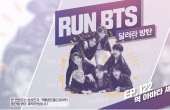Art that makes you cringe
Choi Sun’s paintings make people step back and cringe.
His recent work “Bloody Excrement (Integral Calculus Painting),” an abstract painting in red and white, delves into the shapes of his own excrement.
And this is how he made it: The artist took a laxative that patients take before colonoscopies. In the mess he got from the induced bowel disorder, he tried to find shapes, thinking that those shapes would probably have never been used in painting.
“The idea came about while I was thinking about what sort of paintings people don’t usually make,” said the 42-year-old artist in the interview with The Korea Herald earlier this month at Songeun Art Space in southern Seoul. The gallery currently is holding his solo exhibition until March 28.
 |
| Artist Choi Sun speaks in front of his painting “Butterflies” on March 6 at Songeun Art Space in Seoul. (Chung Hee-cho/The Korea Herald) |
He has defied traditional painting materials, accepted images in order to challenge the “absolute value given to art.”
He graduated from the art college of Hongik University, one of the nation’s most prestigious art education institutions, which leads major discussions and trends in the Korean art world.
He was an outcast there, too.
Choi’s ideas to disrupt accepted norms in paintings flew in the face of his instructors’ teachings.
“I have been searching for ‘alternative art’ in opposition to the so-called Korean modernism,” he said. “Moreover, (I sought) to challenge the institutionalization of art, which in Korea was formed and solidified in the process of accepting modern Western art.”
His very first project was to scrape off paint from completed paintings.
“On a school day, I was supposed to paint on a canvas. But by mistake, a few paint drops spattered on the wall. I got yelled at by a school facility keeper and I yelled back at him. That started my first work -? scraping paint off a canvas instead of applying it,” he said.
He asked for painting donations from his fellow art students and started to undo the paintings for his first solo exhibition in 2004 entitled “Naked Painting.”
But a night before the exhibition, his mother, who mistook them as trash, threw away most of the works that were supposed to be delivered to the exhibition space next morning. Choi had to recreate works overnight.
Later on, Choi’s ideas expanded to social issues and natural disasters. He visited disaster-stricken areas such as Taean, where the nation’s worst oil spill took place in 2007; Gumi, where a massive leak of hydrofluoric acid gas killed five people in 2012; and provincial towns that were struck by a foot-and-mouth disease outbreak from 2011-2012.
He observed the chaotic scenes and started to produce paintings using materials collected from there.
 |
| Artist Choi Sun speaks in front of his painting “Butterflies” on March 6 at Songeun Art Space in Seoul. (Chung Hee-cho/The Korea Herald) |
He collected the identification numbers of all the pigs slaughtered and printed them in magenta, the color of the stamp used to number pigs, on A4-size paper. He printed it as a 16-kilometer scroll and displayed it for the public at his exhibition at Songeun Art Space in 2011.
Along with the scroll work, a white painting made with lard from the slaughtered pigs was also shown. The work emitted an unpleasant odor when it melted at warm temperatures and hardened at colder temperatures.
Another piece was presented in a transparent isolated room to prevent contact with viewers as it contained poisonous hydrofluoric acid he collected in Gumi.
“It is the most dangerous painting in the world,” he said.
These works won him the 2011 Songeun Art Award given by the Songeun Art and Cultural Foundation, established by the energy company Samtan Corporation.
His works were also showcased outside Korea recently at the 2014 Yokohama Triennale. In an exhibition there, he assembled animal bones into art pieces, in his effort to discover common dreams of East Asian countries.
The idea was derived from the fact that three countries in East Asia -? China, Korea and Japan -? make broth from chicken, beef or pork bones. Rejected by curators at first because of the direct critique of chilled relations among the countries over territorial and historical disputes, the work threw a question to audience -? “what would the dinner table of East Asia look like in 10 years? Will we still be fighting, chewing each other’s bones?”
Choi said he would not veer toward comfort in making art and hoped his path would broaden the conventional view of art.
“I’m not trying to raise an issue or anything. But I think contemporary art should help us contemplate the life we have at this moment. That why I make these rough paintings,” he said.
By Lee Woo-young (wylee@heraldcorp.com)




























